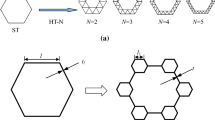Abstract
The epoxy-glass composite pipes of l=330, 800 and 1000 mm in length and φ=30, 35, 41 mm in diameter were subject to torsion till failure. The pipes were formed by filament winding on the mandrel at the angle α=22°,27°,32° for successive diameters. Torsional angle, torsional moment and acoustic emission (AE) were recorded during the test. This paper represents an attempt to use fractal analysis software to process data obtained from AE testing. It shows the dependence of fractal measure and fractal dimension on the amplitude of acoustic events along the axis of the tested pipe in their relation to the spatial distribution of defects in the material.
Similar content being viewed by others
References
Barnsley, M. (1988) Fractals Ewerywhere, Academic press, New York.
Błażzejewski, W. (1999). The influence of fibre filament onto strength of cylindrical elements made of epoxy-glass composite (unpublished doctoral thesis, in Polish), Wrocław.
Cetera, A. (2001). The Minkowski dimension and critical effects in fractal evolution of defects, Chaos, Solitions & Fractals 12, 475–482.
Datta, D., Munshi, P., Kishore, N.N. (1996). Automated Ultrasonic NDE of composite specimens by cluster and fractal analysis, Nondestructive Testing and Evaluation 13, 15–30.
Garrett, K.K., Bailey, J.E. (1977). Multiple transverse fracture in 90° cross-ply laminates of a glass fibre-reinforced polyester. Journal of Materials Science 12, 157–168.
Grayson M. (1983). Encyclopedia of Composite Materials and Composites, John Wiley & Sons, New York.
Królikowski, W. (1986). Resins and Polyester Laminates WNT, Warszawa, 570–600 (in Polish).
Lu Chunsheng, Vere-Jones, D., Hideki Takayasu (1999). Avalanche behavior and statistical properties in a micro crack coalescence process, Physical Review Letters 82.
Lu Chunsheng, Vere-Jones, D., Hideki Takayasu, Alex Yu Tretyakov, and Misako Takayasu (1999). Spatiotemporal seismicity in an elastic block lattice model. Fractals 7.
Owen, M.J. (1978). Composite materials. Fatigue and Fracture 5, 363–393 (Russian translation).
Reifsnider, K. (1980). Fatigue behaviour of composite materials. International Journal of Fracture 16, 563–583.
Rosato, D.V. and Grove, C.S. (1969). Filament Winding. Moscow (Russian translation).
Selden, P.H. (1967). Fibre Reinforced Composites. Springer-Verlag, Berlin (in German).
Rybaczuk, M. and Stoppel, P. (2000). The fractal growth of fatigue defects in materials. International Journal of Fracture 103, 71–94.
Author information
Authors and Affiliations
Rights and permissions
About this article
Cite this article
Cetera, A., BŁażejewski, W. Fractal characteristics of composite pipes defects in torsion testing. International Journal of Fracture 113, 253–265 (2002). https://doi.org/10.1023/A:1014264810113
Issue Date:
DOI: https://doi.org/10.1023/A:1014264810113




